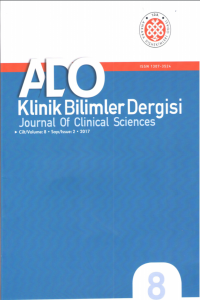İki Farklı CAD/CAM Materyalinin Farklı Kalınlıklarda Translusensi Özelliğinin Değerlendirilmesi
CAD/CAM cam-seramik materyal, CAD/CAM rezin-seramik materyal, Spektrofotometre, Translusensi parametresi
Evaluatıon of Translucency Parameter of Different Thickness of two CAD/CAM Materials
___
- 1. Chaiyabutr Y, Kois JC, LeBeau D, Nunokawa G. Effect of abutment tooth color, cement color, and ceramic thickness on the resulting optical color of a CAD/CAM glass-ceramic lithium disilicate-reinforced crown. J Prosthet Dent. 2011;105(2):83–90.
- 2. Wahba MM, Sherif AH, El-Etreby AS, Morsi TS. The effect of different surface treatments on color and translucency of bilayered translucent nano-crystalline zirconia before and after accelerated aging. Brazilian Dent Sci. 2019;22(2):203–12.
- 3. Hassan SZ, Fathelbab E, Shalaby MM. The effeCT Of LUTINg AgeNT ShADeS AND ThICkNeSS Of hybRID CeRAmICS ON The PeRCeIveD fINAL COLOR. Dent J. 2018;64(53):60.
- 4. Duarte S, Sartori N, Phark J-H. Ceramic-reinforced polymers: CAD/CAM hybrid restorative materials. Curr Oral Heal Reports. 2016;3(3):198–202.
- 5. Pecho OE, Ghinea R, Ionescu AM, Cardona JC, Della Bona A, del Mar Pérez M. Optical behavior of dental zirconia and dentin analyzed by Kubelka–Munk theory. Dent Mater. 2015;31(1):60–7.
- 6. Hoorizad M, Valizadeh S, Heshmat H, Tabatabaei SF, Shakeri T. Influence of resin cement on color stability of ceramic veneers: in vitro study. Biomater Investig Dent. 2021;8(1):11–7.
- 7. Acar O, Yilmaz B, Altintas SH, Chandrasekaran I, Johnston WM. Color stainability of CAD/CAM and nanocomposite resin materials. J Prosthet Dent. 2016;115(1):71–5.
- 8. Drummond JL, King TJ, Bapna MS, Koperski RD. Mechanical property evaluation of pressable restorative ceramics. Dent Mater. 2000;16(3):226–33.
- 9. KÖKAT AM, KÖKAT AD. Monolithic CAD/CAM restorations–Esthetic Zone Applications. J Exp Clin Med. 2021;38(3s):180–7.
- 10. Nogueira AD, Della Bona A. The effect of a coupling medium on color and translucency of CAD–CAM ceramics. J Dent. 2013;41:e18–23.
- 11. Wyszecki G, Stiles WS. Color science: concepts and methods, quantitative data and formulas. 1982;
- 12. Bayindir F, Koseoglu M. The effect of restoration thickness and resin cement shade on the color and translucency of a high-translucency monolithic zirconia. J Prosthet Dent. 2020;123(1):149–54.
- 13. Erdemir U, Yıldız E, Eren MM. Effects of sports drinks on color stability of nanofilled and microhybrid composites after long-term immersion. J Dent. 2012;40:e55–63.
- 14. Lehmann KM, Igiel C, Schmidtmann I, Scheller H. Four color-measuring devices compared with a spectrophotometric reference system. J Dent [Internet]. 2010;38(SUPPL. 2):e65–70. Available from: http://dx.doi.org/10.1016/j.jdent.2010.07.006
- 15. Paul SJ, Peter A, Rodoni L, Pietrobon N. Conventional visual vs spectrophotometric shade taking for porcelain-fused-to-metal crowns: a clinical comparison. J Prosthet Dent. 2004;92(6):577.
- 16. Paravina RD, Roeder L, Lu H, Vogel K, Powers JM. Effect of finishing and polishing procedures on surface roughness, gloss and color of resin-based composites. Am J Dent. 2004;17(4):262–6.
- 17. Dozić A, Kleverlaan CJ, El‐Zohairy A, Feilzer AJ, Khashayar G. Performance of five commercially available tooth color‐measuring devices. J Prosthodont. 2007;16(2):93–100.
- 18. Kim-Pusateri S, Brewer JD, Davis EL, Wee AG. Reliability and accuracy of four dental shade-matching devices. J Prosthet Dent. 2009;101(3):193–9.
- 19. Hasegawa A, Ikeda I, Kawaguchi S. Color and translucency of in vivo natural central incisors. J Prosthet Dent. 2000;83(4):418–23.
- 20. Saygili G, Şahmali S, Demirel F. Colour stability of porcelain repair materials with accelerated ageing. J Oral Rehabil. 2006;33(5):387–92.
- 21. Mirzaie M, Pahlavan A, Hooshmand T, Safaee H, Khalesi Tooyrekani R. Effect of Accelerated Aging on Color Stability of Two Silica-Based Ceramics with Leucite and Lithium-Disilicate Crystalline Phases After Glazing and Polishing. J Islam Dent Assoc Iran. 2018;30(1):21–31.
- 22. Vichi A, Ferrari M, Davidson CL. Influence of ceramic and cement thickness on the masking of various types of opaque posts. J Prosthet Dent. 2000;83(4):412–7.
- 23. Niu E, Agustin M, Douglas RD. Color match of machinable lithium disilicate ceramics: Effects of cement color and thickness. J Prosthet Dent. 2014;111(1):42–50.
- 24. Barizon KTL, Bergeron C, Vargas MA, Qian F, Cobb DS, Gratton DG, et al. Ceramic materials for porcelain veneers: part II. Effect of material, shade, and thickness on translucency. J Prosthet Dent. 2014;112(4):864–70.
- 25. Wang F, Takahashi H, Iwasaki N. Translucency of dental ceramics with different thicknesses. J Prosthet Dent. 2013;110(1):14–20.
- 26. Alayad AS, Alqhatani A, Alkatheeri MS, Alshehri M, AlQahtani MA, Osseil AE Bin, et al. Effects of CAD/CAM ceramics and thicknesses on translucency and color masking of substrates. Saudi Dent J. 2020;
- 27. Malkondu O, Tinastepe N, Kazazoglu E. Influence of type of cement on the color and translucency of monolithic zirconia. J Prosthet Dent. 2016;116(6):902–8.
- 28. Sulaiman TA, Abdulmajeed AA, Donovan TE, Ritter A V, Vallittu PK, Närhi TO, et al. Optical properties and light irradiance of monolithic zirconia at variable thicknesses. Dent Mater. 2015;31(10):1180–7.
- 29. Ryan E-A, Tam LE, McComb D. Comparative translucency of esthetic composite resin restorative materials. J Can Dent Assoc. 2010;76:a84–a84.
- ISSN: 1307-3540
- Yayın Aralığı: Yılda 3 Sayı
- Başlangıç: 2006
- Yayıncı: Ankara Diş Hekimleri Odası
Covid-19 Sürecinde Diş Hekimliği Eğitimi: Etkisi, Gelişen Teknolojiler ve Eğilimler
Zuhal ÇAYIRTEPE, Figen ÇİZMECİ ŞENEL
Çiğdem ŞENTÜRK ÜRER, Özgün YILDIRIM, Berrin IŞIK, Mehmet Barış ŞİMŞEK
Protetik Diş Hekimliğinde Polietereterketon Materyalinin Yeri
Emine Hülya DEMİR SEVİNÇ, Ceyda Başak İNAL, Cemal AYDIN
Mandibuler Anestezi için Vazirani-Akinosi Kapalı Ağız Tekniği
Cevahir CENGİZ, Gülşah KARATAŞ, Sara SAMUR ERGÜVEN
Yeni Tip Koronavirüs (COVID-19) Salgınının Diş Hekimlerinin Tedavi Kliniği Düzeni Üzerine Etkisi
Onur Altuğ SAKALLI, Sedanur SAKALLI, Aleyna Öykü AKBAŞAK, Selim ERKUT
Apoptoz ilişkili PDCD4: Oral kanserin erken tanısında umut vaadedici yeni bir biyobelirteç
Leyla BOZDAĞ, Leyla AÇIK, Halil ERSOY, Ömer BAYIR, Mehmet Hakan KORKMAZ, Nur MOLLAOĞLU, Sibel Elif GÜLTEKİN
Silikon Replika Dayanak ile Ekstraoral Simantasyon Tekniği: Olgu Sunumu
Bütüncül Tıp Bakış Açısıyla Uyku Bruksizmi
Ekstraoral Parlatma İşlemlerinin Translüsent Monolitik Zirkonyanın Yüzey Pürüzlülüğüne Etkisi
Sevinç ERTUĞRUL, Seda YILDIRIM, Bulem YÜZÜGÜLLÜ
Diş Hekimliğinde Oromaksillofasiyal Bölgeden Alınabilen Mezenkimal Kök Hücreler
